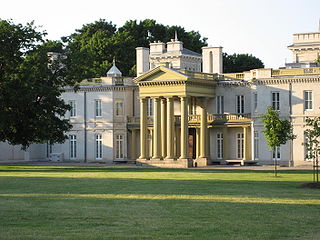James Watson is an American biologist and chemist, the co-discoverer of the double-helical structure of DNA, awarded the 1962 Nobel Prize in Physiology or Medicine.

His Majesty's Advocate, known as the Lord Advocate, is the chief legal officer of the Scottish Government and the Crown in Scotland for both civil and criminal matters that fall within the devolved powers of the Scottish Parliament. They are the chief public prosecutor for Scotland and all prosecutions on indictment are conducted by the Crown Office and Procurator Fiscal Service in the Lord Advocate's name on behalf of the Monarch.

The United States District Court for the District of Oregon is the federal district court whose jurisdiction comprises the state of Oregon. It was created in 1859 when the state was admitted to the Union. Appellate jurisdiction belongs to the United States Court of Appeals for the Ninth Circuit. Matthew P. Deady served as its first judge. Marco A. Hernandez is the current chief judge.

Dundurn Castle is a historic neoclassical mansion on York Boulevard in Hamilton, Ontario, Canada. The 1,700-square-metre (18,000 sq ft) house took three years and $175,000 to build, and was completed in 1835. The forty-room castle featured the latest conveniences of gas lighting and running water. It is currently owned by the City of Hamilton, which purchased it in 1899 or 1900 for $50,000. The city has spent nearly $3 million renovating the site to make it open to the public. The rooms have been restored to the year 1855 when its owner Sir Allan Napier MacNab, 1st Baronet, was at the height of his career. Costumed interpreters guide visitors through the home, illustrating daily life from the 1850s. Camilla, Queen of Canada, a descendant of Sir Allan MacNab, is the Royal Patron of Dundurn Castle.
The Office of the Supervising Architect was an agency of the United States Treasury Department that designed federal government buildings from 1852 to 1939.

The Pioneer Courthouse is a federal courthouse in Portland, Oregon, United States. Built beginning in 1869, the structure is the oldest federal building in the Pacific Northwest, and the second-oldest west of the Mississippi River. Along with Pioneer Courthouse Square, it serves as the center of downtown Portland. It is also known as the Pioneer Post Office because a popular downtown Portland post office was, until 2005, located inside. The courthouse is one of four primary locations where the United States Court of Appeals for the Ninth Circuit hears oral arguments. It also houses the chambers of the Portland-based judges on the Ninth Circuit.

Hamilton Grange National Memorial, also known as The Grange or the Hamilton Grange Mansion, is a National Park Service site in St. Nicholas Park, Manhattan, New York City, that preserves the relocated home of U.S. Founding Father Alexander Hamilton. The mansion holds a restoration of the interior rooms and an interactive exhibit on the newly constructed ground floor for visitors. The Hamilton Heights subsection of Harlem derived its name from Hamilton's 32-acre estate there.

The Neill–Cochran House Museum is a historic home in north-central Austin, Texas. Master builder Abner Cook designed and built the house in 1855 as a suburban estate many years before the surrounding area was settled by other homes and businesses. The two-story Greek Revival home features prominent Doric columns and Mr. Cook's signature "sheaf of wheat" balusters.

The Lane–Hooven House is a historic house museum in Hamilton, Ohio. Built in 1863 for Clark Lane, a Hamilton industrialist and philanthropist, the octagonal house features a brick exterior with Gothic Tudor elements. Other features include an open spiral staircase extending from the basement to the third floor turret, cast-iron fence, a greenhouse and a fountain. It was listed in the National Register on October 25, 1973.

George W. P. Joseph was an attorney and Republican politician in the U.S. state of Oregon. A native of California, his family relocated to Oregon when he was young. There he would practice law and serve in the Oregon State Senate.

The Abbott Farm Historic District is a National Historic Landmark archaeological site in New Jersey. It is the largest known Middle Woodland village of its type on the East Coast of the United States. Significant evidence suggests that the Delaware River floodplain was occupied by Paleoindian people for a long period. It was inhabited between 500 BC and 500 AD. It has been a source of controversy and debate around early development.

Whidden & Lewis was an architectural firm based in Portland, Oregon, in the United States, around the beginning of the 20th century, formed by William M. Whidden and Ion Lewis. The partnership was established in 1889. Their residential buildings were mostly in the Colonial Revival style, while their commercial buildings were primarily in the 20th-century classical style. The commercial buildings often featured brick, along with terra cotta ornamentation. Many of their buildings are listed on the National Register of Historic Places (NRHP).
Hamilton House may refer to:

Woodlawn Cemetery, located in Fairmont, West Virginia is an example of the rural cemetery. It was laid out by Tell W. Nicolet of the firm of Morris and Knowles of Pittsburgh, PA. It is listed on the National Register of Historic Places as a historic district. Today, the cemetery covers 42 acres (170,000 m2) and has over 15,000 burials.

George Greenwood Bingham was an American judge and legal educator in the state of Oregon. A native of Wisconsin, his family immigrated to Oregon in his teens, though he returned to the Midwest for his legal education. Bingham served as the second dean at the Willamette University College of Law and was also a judge for Multnomah County after previously serving as a district attorney for Salem and the state. His former home in Salem, the Dr. Luke A. Port House, is listed on the National Register of Historic Places.

William Christmas Knighton was an American architect best known for his work in Oregon. Knighton designed the Governor Hotel in Portland, Johnson Hall at the University of Oregon, and the Oregon Supreme Court Building and Deepwood Estate in Salem. He served as Oregon's first state architect from 1911–1915, appointed by Governor Oswald West. By 1915, Knighton had designed ninety building projects as state architect. In 1919, Knighton was appointed by Governor Ben Olcott as the first president of the Oregon State Board of Architectural Examiners, a position he held until 1922. In 1920, Knighton was elected the sixth president of the Oregon Chapter of the American Institute of Architects. He remained on the chapter's board of trustees for several years and was chair of the Chapter Legislative Committee into the 1930s.

The Isaac Watson House is the headquarters of the New Jersey State Society of the National Society of the Daughters of the American Revolution (DAR). It is located just outside the state capital of Trenton in Hamilton Township, Mercer County, New Jersey. It is situated on a bluff overlooking Watson's Creek and the Abbott Farm National Historic Landmark in John A. Roebling Park, a 257-acre nature preserve.

The John N. and Cornelia Watson House is a historic house located in Lakeview, Oregon.

Hamilton Forbush "Ham" Corbett was a prominent Portland, Oregon businessman and in his younger years was a leading amateur American football player. He played college football for Harvard University and was a consensus first-team selection to the 1908 College Football All-America Team.

US Senator James F. Wilson House, also known as the Hamilton House and the Fulton House, is a historic residence located in Fairfield, Iowa, United States. This house was built for attorney William L. Hamilton in 1854. Its notoriety is derived from the residency of James F. Wilson, who lived here from 1863 to 1895.



















